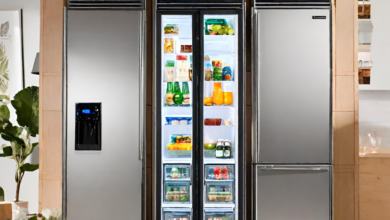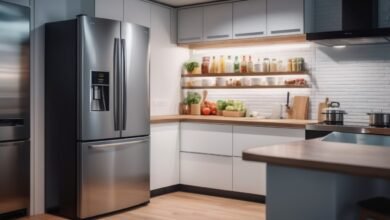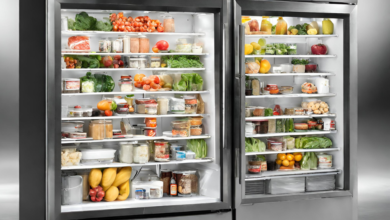Unveiling the Art of Increasing Refrigerator Durability: A Deep Dive

Your refrigerator, often the unsung hero in your kitchen, diligently works to keep your food fresh. However, this vital appliance has its limitations, and understanding how to enhance its durability is crucial. In this comprehensive guide, we will delve into proven methods that go beyond routine maintenance, offering a deep and detailed exploration into the art of increasing refrigerator durability.
I. Understanding the Dynamics of Durability
Durability is not a singular attribute but a culmination of various factors that contribute to the longevity of your refrigerator. Let’s dissect these elements to gain a profound understanding.
A. Material Quality and Construction
1. Chassis Integrity
The foundation of durability lies in the construction of the refrigerator chassis. Opt for models with robust materials and meticulous assembly. Stainless steel exteriors and reinforced internal structures often indicate a commitment to longevity.
2. Quality of Insulation
Inspect the insulation materials used in your refrigerator. High-quality insulation not only enhances energy efficiency but also contributes to the longevity of the compressor by reducing its workload.
B. Compressor Efficiency
1. Role of the Compressor
The compressor is the heart of your refrigerator, responsible for maintaining the desired temperatures. Opt for models with high-efficiency compressors, as they not only contribute to energy savings but also experience less wear and tear over time.
2. Inverter Technology
Consider refrigerators equipped with inverter technology. This innovation allows the compressor to operate at variable speeds, adjusting its power according to the cooling demand. Inverter technology not only improves energy efficiency but also enhances the compressor’s lifespan.
II. Temperature Management Strategies
The ability to maintain optimal temperatures is paramount for both food preservation and the longevity of your refrigerator. Let’s explore methods to master temperature management.
A. Precise Calibration
1. Digital Thermostats
Invest in refrigerators equipped with digital thermostats for precise temperature control. These advanced systems allow you to set and maintain temperatures with greater accuracy, reducing unnecessary strain on the compressor.
2. Routine Temperature Checks
Make temperature checks a routine part of refrigerator care. Utilize appliance thermometers to monitor both the refrigerator and freezer compartments, ensuring they consistently operate within the recommended temperature ranges.
B. Strategic Loading and Organization
1. Airflow Optimization
Efficient airflow is crucial for temperature consistency. Avoid overloading your refrigerator, as this can obstruct airflow, forcing the compressor to work harder. Maintain organized shelves to allow cool air to circulate freely.
2. Zoning for Temperature Sensitivity
Strategically organize items based on their temperature sensitivity. Store perishables requiring lower temperatures in areas with more stable conditions, minimizing temperature fluctuations and preserving the compressor’s lifespan.
III. Maintenance as a Ritual
Routine maintenance is the cornerstone of increasing refrigerator durability. Adopting it as a ritual ensures that your appliance remains in optimal condition throughout its lifecycle.
A. Condenser Coil Care
1. Cleaning Frequency
Regularly clean the condenser coils to remove accumulated dust and debris. These coils facilitate heat exchange, and a clean surface ensures efficient operation, reducing strain on the compressor.
2. Location Awareness
Be mindful of the condenser coil location. Some models have coils at the back, while others have them at the bottom. Knowing their placement allows you to clean them more effectively.
B. Gasket and Seal Integrity
1. Gasket Inspection
Regularly inspect the door gaskets for any signs of wear, tear, or damage. Damaged gaskets compromise the seal, leading to temperature fluctuations and increased workload on the compressor.
2. Cleaning and Lubrication
Clean the gaskets regularly to remove dirt or residue that could affect their flexibility. Additionally, consider applying a thin layer of silicone-based lubricant to maintain gasket elasticity.
C. Interior Cleanliness
1. Scheduled Purges
Conduct scheduled purges of your refrigerator’s contents. Remove expired items, spills, and crumbs. A clean interior not only enhances airflow but also prevents the growth of mold and bacteria.
2. Deodorizing Techniques
Use natural deodorizing agents like baking soda to absorb odors and maintain a fresh interior. Regularly replace or refresh these agents to ensure their effectiveness.
IV. Energy Efficiency Measures
Energy-efficient operation is not only environmentally friendly but also a key factor in increasing refrigerator durability. Let’s explore strategies for optimizing energy efficiency.
A. Energy Star Certification
1. Benefits of Energy Star
Choose refrigerators with Energy Star certification. These models adhere to stringent energy efficiency standards, indicating a commitment to reduced energy consumption and, consequently, less strain on the compressor.
2. Upgrading to Energy-Efficient Models
Consider upgrading to newer models that incorporate energy-efficient technologies. Advances such as LED lighting, improved insulation, and smart features contribute to reduced energy consumption and increased durability.
B. Temperature Settings Adjustment
1. Seasonal Variations
Adjust temperature settings based on seasonal variations. During colder seasons, consider slightly raising the temperature settings to reduce the workload on the compressor.
2. Utilizing Eco Modes
Explore and activate any eco-friendly or energy-saving modes that your refrigerator may offer. These modes optimize energy consumption without compromising food preservation, contributing to prolonged durability.
V. Proactive Troubleshooting and Repairs
Addressing issues promptly and proactively is a fundamental aspect of increasing refrigerator durability. Let’s explore troubleshooting and repair strategies.
A. Unusual Noises Investigation
1. Identification of Sounds
Familiarize yourself with the normal operating sounds of your refrigerator. Unusual noises, such as grinding, rattling, or clicking, can be early indicators of potential issues. Investigate and address these promptly.
2. Professional Inspection
If unusual noises persist, consult with a professional technician. Early intervention can prevent minor issues from escalating into major problems, preserving the overall health of your refrigerator.
B. Leak Detection and Prevention
1. Periodic Inspection
Regularly inspect your refrigerator for any signs of water leakage. Check beneath the appliance, around the water supply line, and in the drip pan. Prompt detection prevents water damage and potential corrosion.
2. Addressing Leaks
If you detect leaks, identify and address the source immediately. Leaks can damage internal components and compromise the structural integrity of your refrigerator.
VI. Extended Periods of Inactivity and Vacation Mode
Preparing your refrigerator for extended periods of inactivity, such as vacations, is a proactive strategy to ensure its durability.
A. Emptying and Cleaning
1. Removing Perishables
Before an extended absence, empty your refrigerator of perishable items to prevent food spoilage. This step also allows for a more thorough cleaning of the interior.
2. Cleaning and Deodorizing
Clean the interior with a mild detergent, paying attention to corners and shelves. Place deodorizers or absorbents to prevent unpleasant odors during the inactive period.
B. Temperature Adjustment or Power Off
1. Energy Conservation
Consider adjusting the temperature settings to a slightly higher level or even turning off the refrigerator if you’ll be away for an extended
period. This conserves energy and reduces wear on the compressor.
2. Doors Ajar for Ventilation
Leave the refrigerator doors slightly ajar during periods of inactivity to prevent the growth of mold and maintain proper ventilation.
VII. Upgrading vs. Repairing Dilemma
The decision between upgrading and repairing your refrigerator involves a thoughtful analysis of costs and benefits.
A. Assessing Repair Costs
1. Cost-Benefit Analysis
Evaluate the cost of repairs against the current value of your refrigerator. If the cost of repairs is close to or surpasses the appliance’s value, it may be more economical to consider an upgrade.
2. Professional Consultation
Seek the opinion of a professional technician for a detailed assessment. They can provide insights into the potential longevity of your refrigerator post-repairs.
B. Technological Advancements and Features
1. Evaluating Newer Models
Explore the features and technological advancements offered by newer refrigerator models. Upgrading to a more energy-efficient and technologically advanced appliance may provide benefits that outweigh the costs of repairs.
2. Energy Efficiency Considerations
Consider the long-term energy efficiency gains of newer models. While the upfront cost may be higher, the reduced energy consumption can contribute to increased durability over time.
VIII. Conclusion: The Symphony of Durability
In the intricate symphony of refrigerator durability, each element plays a unique role, contributing to the harmonious preservation of this essential kitchen appliance. From understanding the nuances of material quality to proactive maintenance rituals and strategic energy efficiency measures, the art of increasing refrigerator durability involves a comprehensive approach.
By immersing yourself in this detailed guide, you’ve gained insights into the multifaceted world of refrigerator care. Now, armed with knowledge, you can orchestrate the longevity of your refrigerator, ensuring it remains a steadfast companion in your kitchen for years to come. Embrace the art of durability, and let your refrigerator resonate as a testament to the meticulous care invested in its preservation.






